Exploring the Architectural and Cultural Impact of Al Rihab Tower
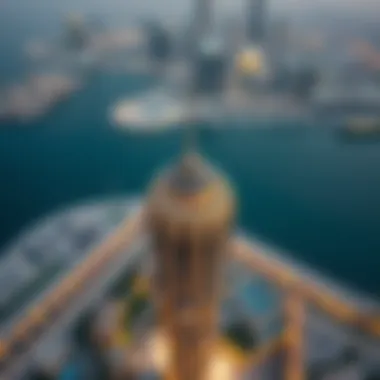
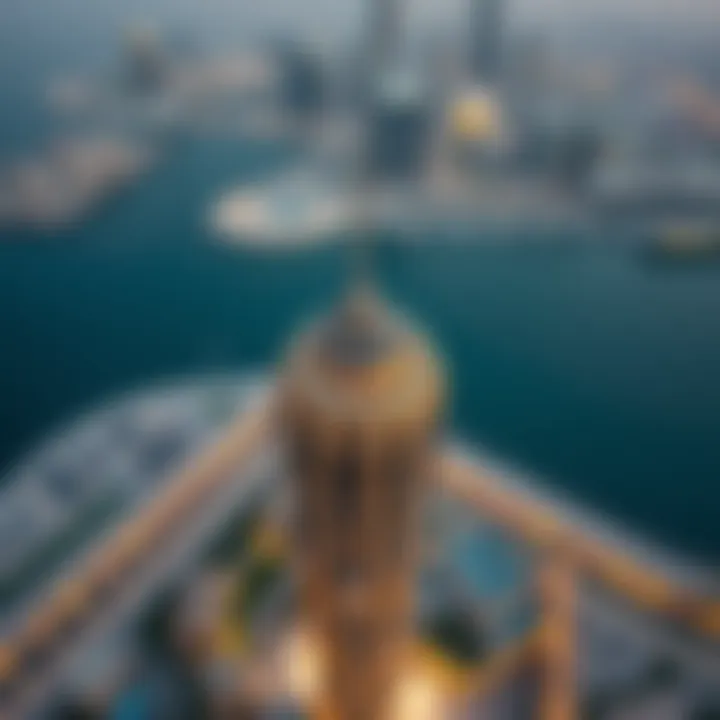
Intro
The Al Rihab Tower stands as a defining symbol in the ever-evolving panorama of Dubai's skyline. Not just another addition to the city's architectural complexity, the tower possesses layers of significance that reach far beyond its striking facade. Throughout this article, we will unfold the architectural distinctiveness of Al Rihab Tower, explore its cultural relevance, and examine its significant role within Dubai's dynamic real estate landscape.
From the intricacies of its design to the multitude of investment opportunities it presents, this exploration aims to provide a comprehensive look for investors, real estate agents, and developers keen on tapping into the vibrant market that Dubai has to offer.
The allure of Al Rihab Tower lies not just in its physical presence, but in its capacity to reflect the rapid urban development around it and the evolving identity of contemporary Dubai. In doing so, we will uncover insights that pave the way for informed investment decisions in a landscape where foresight can lead to substantial rewards.
So, buckle up as we dive into the architectural marvel that is Al Rihab Tower and navigate through the strategies that can be employed for success in this flourishing real estate market.
Market Trends
Current Market Analysis
Dubai’s real estate market has undergone transformative changes over the past decade, and Al Rihab Tower is at the heart of this evolution. The tower, with its distinctive design and strategic location, taps into the rising demand for luxury living spaces coupled with commercial opportunities. Investors are keeping a close eye on the trends, as they indicate that properties in close proximity to prominent landmarks like Al Rihab Tower tend to maintain substantial value.
Moreover, the COVID-19 pandemic has reshaped the market dynamics. There is a noticeable shift towards residential spaces that offer a blend of comfort and accessibility. Al Rihab Tower, with its modern amenities and aesthetic appeal, has emerged as a favorable choice for both investors and residents alike. The demand for such living spaces is evident in the increasing rental yields, which have shown an upward trend despite initial market fluctuations.
Future Projections
As we look into the crystal ball, it’s clear that the future prospects for Al Rihab Tower and the surrounding real estate environment are promising. Various reports suggest that property prices in Dubai, particularly in areas surrounding landmark structures, are anticipated to rise as infrastructure developments continue.
"The growth of property value around aesthetically appealing structures leads to enhanced urban experiences, pushing the market upward."
With upcoming projects and government initiatives aimed at easing property regulations for foreign investors, Al Rihab Tower stands poised for even greater prominence in the years to come. This real estate trend not only draws in local investors but also attracts international players seeking to capitalize on the booming market.
Investment Strategies
Best Neighborhoods to Invest In
When it comes to investing in Dubai, location is key. Al Rihab Tower, being centrally located, is surrounded by several up-and-coming neighborhoods that show great potential. Consider taking a look at the following areas:
- Dubai Marina: With its stunning views and vibrant lifestyle, it has always been on the radar for luxury living.
- Downtown Dubai: Home to iconic landmarks, this area continues to attract a high volume of both residential and commercial investments.
- Jumeirah Lake Towers: Known for its community feel and accessibility, it's time to keep an eye on this spot as it’s evolving rapidly.
Tips for First-Time Investors
Venturing into Dubai's real estate market can be an exhilarating yet daunting experience for first-time investors. Here are a few tips to get you started:
- Research Thoroughly: Understand the trends, property values, and investment hotspots like Al Rihab Tower.
- Network: Connect with real estate professionals to get insights and market dynamics. Join local forums or platforms like Reddit or Facebook groups focused on Dubai’s real estate.
- Be Mindful of Regulations: Familiarize yourself with the legalities surrounding property ownership in Dubai, especially for non-residents.
- Consider Long-Term Gains: While short-term flips can be appealing, focusing on properties with long-term rental potential like those in and around Al Rihab Tower might serve you better in the long run.
As the demand for properties continues to climb, aligning with these strategies can position investors to make the most out of their investment endeavors.
Preface to Al Rihab Tower
Al Rihab Tower stands as a significant landmark in Dubai, showcasing not just architectural excellence but also embodying the cultural narratives of this vibrant city. Understanding this tower is like peeling an onion; there are layers of history, design, and societal impacts that come into play. The discourse surrounding Al Rihab Tower is pivotal not only for architects and designers but also for investors and real estate professionals looking for insight into the evolving skyline of Dubai.
Overview of the Structure
Al Rihab Tower is a striking example of modern architecture fused with elements that reflect local culture. Its height reaches impressive dimensions, and the unique silhouette towering above the city serves a dual purpose: a functional space for business and a visual beacon for urban identity.
From its meticulously designed facades to the intelligently utilized interior layouts, every inch has been crafted with purpose. The tower features glass and steel materials that not only enhance aesthetic appeal but also improve energy efficiency. As the sun shifts in the sky, the reflections on the glass offer an ever-changing canvas, showcasing not just the tower itself but encapsulating the dynamic nature of Dubai as a whole.
Historical Context
The inception of Al Rihab Tower did not just emerge out of a whim; it has roots intertwined with the rapid development of Dubai as a global hub. Back in the early 2000s, the city faced tremendous growth, and the demand for contemporary commercial spaces surged. Al Rihab Tower was constructed during this transformative phase, reflecting not only the architectural ambitions of its time but also responding to the economic challenges and opportunities present in the region.
As Dubai transitioned from a modest fishing village to a cosmopolitan metropolis, structures like Al Rihab Tower contributed significantly to this trajectory. It marked a point where traditional values met contemporary aspirations, encapsulating a moment in history where the city's identity reshaped itself amidst globalization. The tower serves as a reminder of the city’s journey—a story of ambition and resilience, and a symbol of Dubai's undeterred progress into the future.
In exploring Al Rihab Tower, one uncovers not just a building, but a piece of the puzzle—laying bare the intersections of culture, economy, and architectural innovation that define Dubai today.
Architectural Features
Understanding the architectural features of Al Rihab Tower is crucial for grasping its place in Dubai's skyline and cultural narrative. The design principles, materials, and techniques employed in the construction of this tower reflect not just aesthetics, but also a deeper intention of embodying a modern yet culturally resonant image of the city. Discussing its architectural features gives insights into how the tower stands apart in a city that thrives on innovation and grandeur.
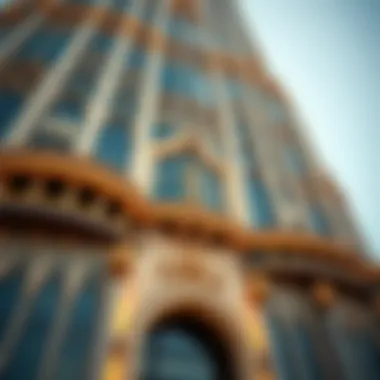
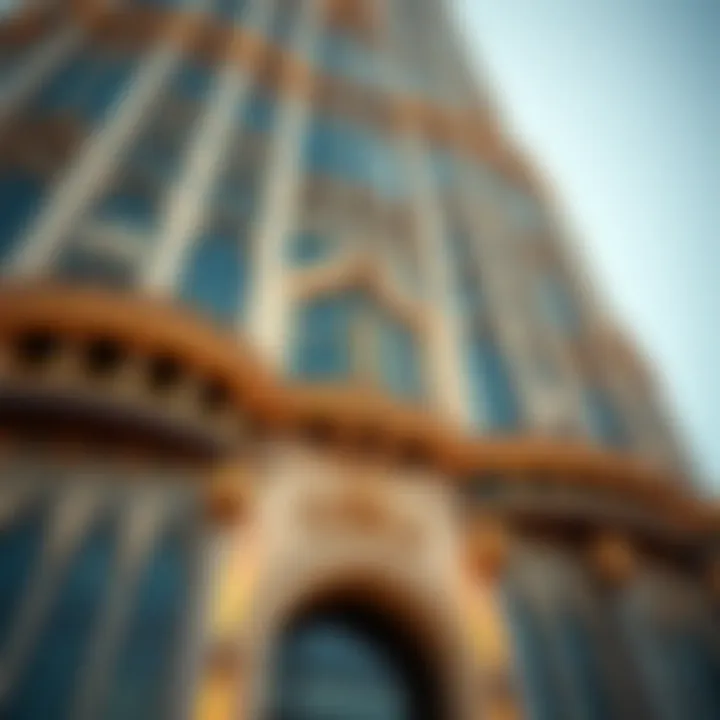
Design Elements
The design of Al Rihab Tower is a tapestry woven with elements that speak of both modernity and a nod to the traditional. From its angular facade to the sweeping curves that accompany it, every line seems to tell a story.
- Curvilinear Shapes: The building’s exterior incorporates curvilinear shapes, which not only soften the overall appearance but also symbolize the fluidity and rapid growth of Dubai. This is particularly noticeable in how the tower rises gracefully from its base.
- Vibrant Facades: Color plays a pivotal role in its design. Shimmering glass panels reflect the sunlight, creating a dynamic play of colors that changes throughout the day. This approach also serves a practical purpose, as it helps regulate indoor temperatures by utilizing natural light effectively.
- Green Spaces: Al Rihab Tower does not shy away from integrating green spaces within its architecture. Balconies adorned with lush plants give a fresh touch against the stark urban backdrop, contributing to both aesthetic pleasure and environmental sustainability.
"Al Rihab Tower is more than just a building; it’s a symbol of Dubai’s aspiration, merging innovation with cultural reverence."
The entrance to the tower is a sight to behold. Large glass doors open into a grand lobby, often referred to as the heart of the structure. High ceilings and well-placed artwork immediately draw the eye, creating an inviting atmosphere that speaks volumes about the importance of social spaces in modern architecture. Architectural elements such as these invite curiosity and help shape public perception of the building as a vibrant cultural hub.
Materials and Construction Techniques
Materials and construction techniques employed in Al Rihab Tower are equally significant. The choices made during the development process not only illustrate sustainable practices but also ensure structural integrity and aesthetic appeal.
- Sustainable Materials: The team behind Al Rihab Tower embraced eco-friendly materials, from recycled steel to sustainably produced glass, reflecting a commitment to reducing the carbon footprint of constructions. These choices align with a broader effort in Dubai to promote sustainability in urban design.
- Modular Construction Techniques: Leveraging modular construction was a strategic choice that allowed for quicker assembly while maintaining high safety standards. This approach minimized waste and streamlined the building process, an essential factor in today’s fast-paced construction environment.
- Technological Innovations: The integration of cutting-edge technology in building management systems stands out. From smart lighting that adjusts based on daylight to HVAC systems that optimize energy consumption, the tower serves as a case study in how technology can enhance both comfort and efficiency.
In sum, the architectural features of Al Rihab Tower are designed not only as a response to its urban context, but also as an embodiment of Dubai's ambitions. Through careful consideration of design elements and material choices, the tower speaks to a future where sustainability and innovation go hand in hand, making it a critical focal point in Dubai's architectural discourse.
For more on architectural practices and innovations in Dubai, consider visiting Wikipedia or exploring the insights shared on Britannica.
Cultural Significance
Understanding the cultural significance of Al Rihab Tower is essential in appreciating its role within the vibrant tapestry of Dubai. This tower is not merely an architectural marvel; it encapsulates the aspirations and evolving identity of a city that has transformed itself over the last few decades. From its innovative design that beckons the future, to its integration within the local fabric, Al Rihab Tower stands as a beacon of what Dubai symbolizes.
Architectural Influence in Dubai
Al Rihab Tower plays a pivotal role in shaping Dubai's architectural narrative. The design reflects a harmonious blend of modern aesthetics with traditional elements, providing a unique facade that is unmistakably Dubai. It draws inspiration from the city’s rich history while pushing the envelope of contemporary architecture.
- The tower features an elegant glass exterior that captures the desert sunlight, minimizing energy consumption while maximizing visual impact. This smart design is not only appealing but is also environmentally conscious.
- Interior spaces are thoughtfully designed to enhance productivity and well-being, embodying the latest principles in workplace design.
In a city renowned for its towering skyscrapers, Al Rihab Tower stands shoulder to shoulder with other prominent buildings, ultimately influencing future construction projects. Its architectural style has sparked a trend where designers in Dubai aim to incorporate both innovation and sustainability into their projects, creating structures that are as functional as they are visually stunning.
Symbolism in Local Culture
Beyond physical architecture, Al Rihab Tower carries profound symbolism for the local community. It reflects the spirit of growth, resilience, and ambition that drives Dubai forward. For many locals, the tower represents more than just a slice of real estate; it symbolizes the collective dreams of a city that emerged from modest beginnings to become a global hub.
"Al Rihab Tower stands not just as a building, but as a testimony to the aspirations of its people."
Culturally, it acts as a meeting point where traditions meet innovation.
- Civic Pride: Many residents feel proud when they look at the tower, viewing it as a landmark that not only enhances the skyline but also their daily lives.
- Cultural Fusion: By hosting various cultural and business events, the tower serves as a venue for networking among diverse communities, underlining Dubai's commitment to multiculturalism.
Economic Impact
The economic impact of Al Rihab Tower extends far beyond its striking silhouette against the Dubai skyline. This towering structure has become a significant player in the local economy. It acts not just as an architectural wonder but as a catalyst for market growth, influencing various sectors such as real estate, tourism, and business investments. Understanding this impact involves examining specific elements that help paint a clearer picture of its importance.
Market Trends Related to Al Rihab Tower
Al Rihab Tower plays a key role in shaping market trends in Dubai's booming property landscape. Multiple factors contribute to its influence:
- Increasing Demand: With Dubai's population growth and ongoing urban development, there’s a rising interest in commercial spaces. Al Rihab Tower, equipped with modern amenities and strategic location, attracts investors and businesses alike, thus enhancing its value.
- Investment Appeal: Analysts often point to Al Rihab Tower when discussing real estate investments. Its design and strategic positioning make it a golden opportunity for anyone looking to stake a claim in Dubai's lucrative market.
- Rental Market Dynamics: The presence of the tower has also impacted rental prices in the surrounding area. It elevates the local property market by establishing a benchmark for rents, as businesses gravitate toward this prime location. The subsequent increase in rental prices can make or break residential and commercial decisions for landlords and tenants alike.
"Al Rihab Tower exemplifies how a single structure can uplift not just the immediate vicinity but also the broader economic trends in Dubai, establishing benchmarks in both investment and rental markets."
These trends are not merely anecdotal. Data shows a noticeable uptick in property values in the immediate area since the tower's completion, making it a case study for similar ventures.
Investment Opportunities
For savvy investors, Al Rihab Tower represents a chance to dive into Dubai’s dynamic real estate market. Several factors create a fertile ground for investments:
- Strategic Location: Situated in a booming district, the tower offers unparalleled access to transportation, amenities, and business hubs. This makes it an attractive proposition for enterprises looking to set up shop.
- Long-term Growth Potential: The architecture isn’t just visually appealing; it’s also functional. As urbanization continues, the demand for properties like Al Rihab Tower will only increase, translating into long-term benefits for investors who align their portfolios with such properties.
- Government Initiatives: Dubai’s enthusiastic government strategies aiming at attracting foreigners—including various incentives—further bolster the market. Investments in infrastructure and regulatory support make places like Al Rihab Tower a safe bet for real estate investment.
In summary, the economic ramifications associated with Al Rihab Tower are profound. From setting trends in the real estate market to providing solid investment opportunities, it indeed serves as a cornerstone for understanding Dubai’s ever-evolving property landscape. Keeping these insights in mind is crucial for investors and stakeholders as they navigate this vibrant market.
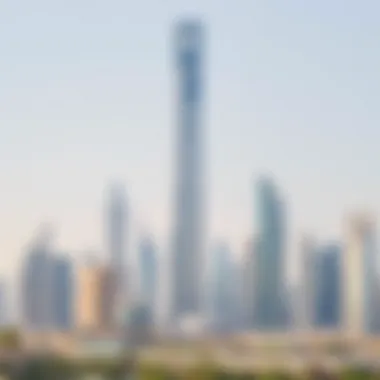
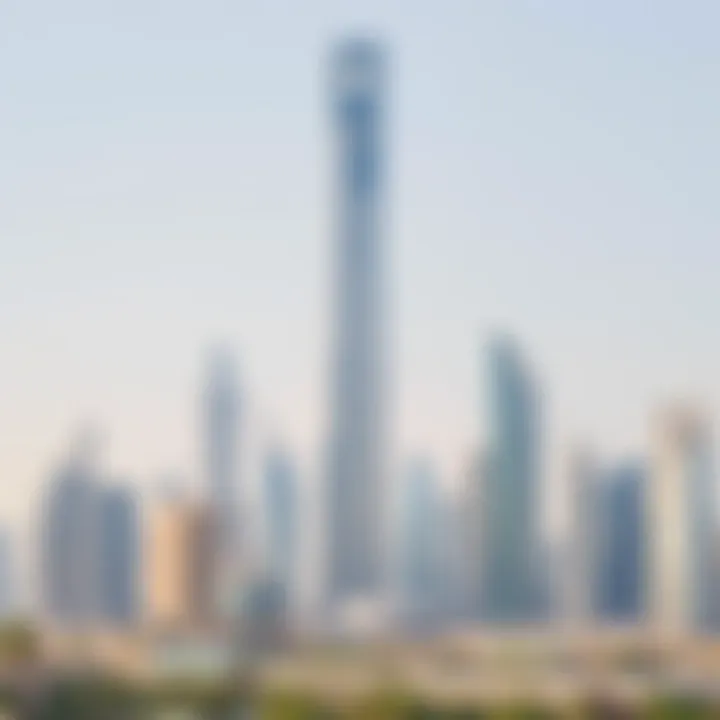
Real Estate Dynamics in Dubai
The real estate landscape in Dubai is a remarkable example of rapid transformation, influenced by various social, economic, and political factors. Understanding the dynamics of this market is essential for investors, real estate agents, developers, and homeowners alike. Given the thriving economy of the UAE, it’s no surprise that Dubai continues to emerge as a major global player in real estate. The city’s unique blend of luxury and functionality attracts not only tourists but also long-term residents, fostering a consistent demand for housing and commercial spaces.
Comparative Analysis with Other Towers
When comparing Al Rihab Tower with other iconic structures in Dubai, several key factors come into play. The Burj Khalifa, for instance, stands out both in height and architectural ingenuity. However, Al Rihab Tower represents a different facet of Dubai's ambition, focusing on integrated living spaces that combine residential and commercial needs. This dual-purpose approach makes it particularly appealing to buyers who prioritize convenience and community.
- Architectural Style: While the Burj Khalifa dazzles with modern design and engineering marvel, Al Rihab Tower channels a sense of cultural identity with its unique features that resonate with local traditions.
- Affordability and Accessibility: Al Rihab caters to a segment of the market looking for more accessible price points without sacrificing quality. This broadens its appeal in ways that other high-profile towers may not.
- Amenities Offered: The tower is equipped with facilities like retail spaces, fitness centers, and communal areas, enhancing its attractiveness as a functional living environment.
Overall, Al Rihab Tower contributes to the diversity of the Dubai skyline, complementing other structures while catering to a distinct demographic.
Future Developments in the Area
Looking ahead, the area surrounding Al Rihab Tower is poised for significant development. Several upcoming projects promise to enhance the vibrancy of the neighborhood, thus impacting the tower’s market position.
- Infrastructure Improvements: Planned upgrades to transport links, including a new metro station, will facilitate easier access to the tower, potentially increasing its value.
- Commercial Ventures: As more businesses set up shop nearby, the demand for residential options like Al Rihab is expected to grow, making it a prime location for both investors and tenants.
- Community Initiatives: Local government aims to create more parks, cultural spaces, and leisure activities that will enhance the living environment around Al Rihab Tower and attract families.
In sum, understanding these future developments is crucial for stakeholders. Strong local initiatives paired with infrastructural enhancements will not only increase Al Rihab Tower’s value but also reinforce its role as a catalyst for community and cultural growth within Dubai, ensuring it remains a crucial player in the dynamic real estate landscape.
Sustainability Initiatives
Sustainability initiatives are increasingly gaining traction in modern architecture, particularly in a rapidly developing city like Dubai. Al Rihab Tower exemplifies this trend by embracing green practices that align with both environmental responsibility and urban aesthetic. The emphasis on sustainability is not just about preserving the surrounding environment but also reflects a broader commitment to future generations. This section will explore the green design considerations and technological advancements incorporated into the tower, thereby illustrating how Al Rihab Tower can serve as a model for sustainable architecture in urban settings.
Green Design Considerations
One of the cornerstone elements of Al Rihab Tower's sustainability initiatives is its focus on green design. The architects considered various factors in the design phase, focusing on energy efficiency and resource conservation. For instance, the materials sourced for construction were selected for their environmental impact. Low-emission glass and recycled steel dominate the structure, significantly reducing the carbon footprint associated with traditional construction methods.
Moreover, the tower's orientation plays a crucial role in its energy conservation efforts. Careful placement not only maximizes natural light, reducing reliance on artificial lighting, but also takes advantage of local wind patterns, facilitating natural ventilation to cool the building without heavy air conditioning usage.
Some specific design features include:
- Green Roofs: Portions of the roof are covered with vegetation to improve insulation and reduce drainage runoff.
- Water-Efficient Landscaping: Native plant species are used to minimize water consumption.
- Rainwater Harvesting Systems: Collecting rainwater for irrigation minimizes the usage of potable water.
Such thoughtful design not only reduces resource use but also significantly enhances the building's overall aesthetic, making Al Rihab Tower a visual representation of responsible urban development.
Technological Innovations for Sustainability
The technological advancements implemented in Al Rihab Tower further bolster its sustainability initiatives. By integrating innovative technologies, the tower addresses environmental challenges while ensuring operational efficiency. For instance, smart building technologies regulate energy consumption dynamically, allowing the tower to respond to real-time environmental conditions. This adaptive approach ensures that energy use is optimized depending on occupancy and usage patterns.
Among the notable innovations are:
- Solar Panels: Installed on certain sections of the building, they harness renewable energy, greatly reducing dependence on conventional power sources.
- Building Management Systems (BMS): These computerized controls oversee lighting, heating, and cooling systems to operate at peak efficiency without unnecessary energy consumption.
- Advanced Insulation Materials: The use of state-of-the-art insulation techniques minimizes heat loss during colder months and decreases heat intake during hot months, further lowering energy costs.
These technological advancements reveal a commitment not just to sustainability but to creating a self-sufficient ecosystem in which the tower resonates with its environment rather than imposing upon it.
Community Engagement
Community engagement is a crucial component within the tapestry of urban architecture and development, notably in the context of a structure like Al Rihab Tower. Its significance extends beyond mere aesthetics; it touches the lives of individuals and influences their surrounding environment. A well-engaged community can drive projects that not only embody grandeur but also cater to the nuanced needs of the residents and stakeholders involved. Such involvement creates a sense of ownership and pride within the community, ensuring that developments resonate well with the populace rather than stand aloof as mere structures of concrete and steel.
Local Involvement in Development
The local involvement in the development of Al Rihab Tower cannot be overstated. It serves as a bridge between the project developers and the residents of the area. When communities are actively consulted during the planning and operational phases, the resulting feedback can lead to better design choices that reflect local culture and preferences.
For instance, community meetings can provide a platform for residents to express their desires and concerns regarding the tower's impact on local traffic, noise levels, or communal spaces. This engagement also fosters transparent communication, wherein developers can clarify misconceptions and gain insights into the community's expectations.
Here's how local involvement has positively shaped Al Rihab Tower:
- Surveys and Questionnaires: Local residents participated in surveys to guide the tower's design elements, ensuring the final product would meet established community standards.
- Focus Groups: These groups were organized to delve deeper into specific areas, like sustainable practices, which mattered to the community.
- Feedback Mechanisms: Offering channels for ongoing feedback allows for adaptation and response as the project progresses.
Public Perception of Al Rihab Tower
Public perception plays a pivotal role in shaping the identity of Al Rihab Tower within Dubai's landscape. People's views are shaped largely by their understanding of how the tower fits into their daily lives and its broader implications for the community. A structure that fails to resonate with local sentiments may face criticism and detachment, while one that embraces community values is likely to thrive.


As residents and visitors interact with Al Rihab Tower, their experiences will inevitably influence its reputation. Positive perceptions can lead to a strong brand for the tower, attracting potential tenants and visitors alike. Conversely, examples of negative experiences, such as traffic congestion or lack of green space, could tarnish its image.
- Community Events: Hosting local events at or around the tower can create a positive buzz and strengthen ties with the community.
- Social Media Presence: Positive engagement on platforms like Facebook can help shape favorable views about the tower among wider audiences.
In essence, the public perception of Al Rihab Tower is dynamic and rooted in continuous interaction between the structure and the community it serves.
"The foundation of a successful tower is its bond with the community. If residents feel a sense of inclusion, the tower becomes a landmark of pride rather than just a plot on a map."
Ultimately, community engagement not only enhances the architectural endeavor but also enriches the cultural framework surrounding Al Rihab Tower, leaving a lasting legacy in Dubai’s ever-evolving skyline.
Challenges and Criticisms
The construction of Al Rihab Tower has not been without its share of challenges and criticisms, a vital aspect to explore when assessing its broader impact on Dubai's architectural landscape. These challenges encompass a variety of concerns that range from environmental implications, community dissatisfaction, to issues related to construction practices. Understanding these elements is essential for investors and stakeholders who need a realistic view of the complexities surrounding any monumental project.
Controversies Surrounding Construction
Controversies linked to the construction of Al Rihab Tower have sparked debates that illuminate the clash between progress and preservation. One notable point of contention is the tower's overall design aesthetic, which some local critics feel doesn’t resonate with Dubai's heritage buildings. Detractors argue that it stands in stark contrast to the traditional architectural styles that once defined the city's skyline, claiming it prioritizes modernity over cultural context.
Additionally, the construction phase was marked by allegations of poor labor conditions on site. Reports surfaced suggesting that workers faced inadequate safety measures and long hours without fair compensation. These claims raised alarm bells not only among labor rights advocates but also among socially-conscious investors who might reconsider their investment based on ethical grounds.
Another point of dispute was the environmental footprint of the tower. Many voiced concerns about the sustainability of its construction materials and the potential strains on local resources. The debate centered around how Dubai could further its reputation as a forward-thinking city while still maintaining a commitment to environmental sustainability.
"Tall buildings often symbolize deep aspirations; however, they also come with responsibilities towards the local community and environment."
Addressing Concerns from the Community
In light of these criticisms, addressing community concerns has become crucial for developers and city planners. A consultative approach appears to be the emerging solution, where local residents are engaged in discussions about the tower’s impact. Community forums have been initiated to foster dialogue, allowing citizens to voice their opinions and offer constructive feedback on the tower’s design and operations.
Transparency in operations has also taken center stage. The developers have committed to improving labor conditions, pledging to adhere to modern safety standards and fair pay for workers. This move alineted with growing public sentiment in favor of ethical labor practices, aiming to rebuild trust with the community.
Further, efforts towards an environmentally conscious model have included integrating feedback from environmental assessment reports. The tower's design now includes green roofs and energy-efficient technologies aimed at reducing its ecological impact. These measures are not just efforts to appease critics but also reflections of a broader global shift towards sustainable urban development.
By taking tangible steps to resolve the issues surrounding Al Rihab Tower's development, the stakeholders are not only enhancing its reputation but also showcasing the importance of collaborative growth in urban environments. In doing so, the tower’s long-term significance extends well beyond its aesthetic value, as it becomes a symbol of resilience and responsibility amidst challenges.
The Future of Al Rihab Tower
The Al Rihab Tower stands as a beacon of architectural innovation and cultural relevance within the ever-evolving skyline of Dubai. Situated in a city characterized by its rapid growth and ambitious developments, the tower's future is entwined with broader economic and social dynamics. The importance of this topic lies in understanding how this structure will continue to adapt to shifting market demands and community needs. Renovation potential, integration with sustainable practices, and alignment with urban planning will play pivotal roles in determining its trajectory.
Potential for Renovation and Adaptation
Renovation and adaptation are not just possibilities for Al Rihab Tower; they are necessities in the face of a shifting architectural landscape. As technologies advance and design philosophies evolve, so too must our structures. For Al Rihab, this means considering both aesthetic updates and functional enhancements that meet the needs of future occupants.
- Incorporating Smart Technologies: Upgrading the tower with smart technologies can significantly enhance efficiency and appeal. For example, the implementation of advanced climate control systems can improve energy consumption, making the building not only more sustainable but also more appealing to tenants and businesses looking for modern facilities.
- Flexible Space Planning: Today’s tenants often seek spaces that are adaptable. By incorporating modular design elements into the tower's interior, developers can offer flexible office environments that can easily adjust to changing business needs.
- Cultural Relevance Through Design: Renovation should also reflect local cultural preferences and practices, enhancing the tower's resonance within the community. This could mean integrating art or design elements that pay homage to Dubai's rich heritage.
Ultimately, the potential for renovation and adaptation hinges on the willingness of stakeholders to invest time and resources into crafting a vision that breathes new life into Al Rihab Tower, ensuring its relevance in the urban tapestry of Dubai.
Long-term Vision for the Tower within Dubai's Landscape
The long-term vision for Al Rihab Tower is not just about bricks and mortar, but about creating a synergy with the surrounding landscape of Dubai. As city planners envision a future where development aligns harmoniously with community needs, Al Rihab must find its place within this evolving narrative.
- Integration with Urban Development: The future of the tower will involve strategic collaborations with ongoing urban developments. For instance, connections to public transport and pedestrian paths can bolster its accessibility and significance in metropolitan life.
- Sustainability Alignment: Embracing a vision for sustainability is crucial. Plans to incorporate green roofs, energy-efficient systems, and water conservation strategies will position Al Rihab Tower as a model of modern urban living, setting a benchmark for similar projects in Dubai and beyond.
- Cultivating Community Spaces: Beyond serving as a business hub, the tower could evolve into a community center. Spaces for public events, art exhibitions, and local markets could turn it into a vibrant point on the city map, fostering a sense of community and engagement among residents and visitors alike.
In summary, the future of Al Rihab Tower is bright with possibility. It is poised to evolve into a modern, multifunctional structure that reflects Dubai's ambitions. Engaging with community needs, employing sustainable practices, and adapting physically and culturally will ensure that Al Rihab Tower remains a cornerstone of Dubai’s skyline well into the future.
Ending
In wrapping up this exploration into the Al Rihab Tower, it’s clear that this structure holds a prominent place not just as a physical entity in Dubai’s skyline, but as a pivotal cornerstone in the cultural and economic landscape of the city. The architectural intricacies, cultural importance, and potential investment avenues collectively underscore its significance.
Summarizing Key Insights
The examination of Al Rihab Tower reveals several critical insights:
- Architectural Splendor: Al Rihab Tower’s design is an emblem of modernity blended with local aesthetics, setting itself apart in Dubai’s ever-evolving architecture scene. The use of locally sourced materials speaks to a conscious effort to align with sustainable practices within the region.
- Cultural Revitalization: The tower serves as a symbol, sparking conversations about what it means to retain cultural identity amidst rapid urbanization. It’s more than a building; it tells a story about the relationship between heritage and progress.
- Economic Catalyst: The positive impact on local property values indicates the tower's role as a driver of economic growth. It attracts not only tourists but also potential investors drawn to its unique offerings.
This blend of visuals, meanings, and financial implications exemplifies why Al Rihab Tower isn’t merely admired from afar. It invites both criticism and praise, forging a dialogue that can nourish the surrounding community.
Final Thoughts on Investment Potential
Looking ahead, the investment potential surrounding Al Rihab Tower appears robust, backed by data and current trends in Dubai's real estate market. A few key considerations include:
- Market Demand: As Dubai expands, demand for commercial and residential spaces continues to grow. Al Rihab Tower stands poised to benefit from this surge.
- Rental Opportunities: With its prime location, options for leasing office spaces or residential apartments appeal to a broad range of clientele, from startups to established businesses.
- Long-term Value: Given the architectural significance and cultural relevance, investment in Al Rihab Tower can yield significant returns as interest in the Dubai area persists.











